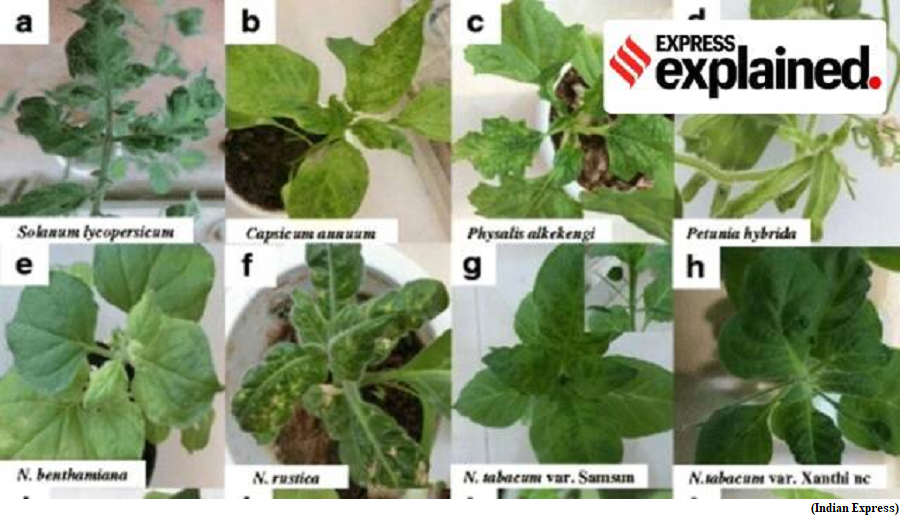The two mosaic viruses that hit tomato crop in Maharashtra and Karnataka (GS Paper 3, Science and Tech)

Why in news?
- Tomato growers in Maharashtra and Karnataka have blamed two different viruses for the loss of yields earlier in 2023.
- Farmers in Maharashtra have said their tomato crop was impacted by attacks of the cucumber mosaic virus (CMV), while growers in Karnataka and other South Indian states have blamed the tomato mosaic virus (ToMV) for crop losses.
- Over the last three years, growers of tomato have complained of increased infestation with these two viruses, leading to partial to complete crop losses.
What are CMV and ToMV?
- The two plant pathogens have similar names and cause similar damage to crops, but they belong to different viral families, and spread differently.
- ToMV belongs to the Virgaviridae family and is closely related to the tobacco mosaic virus (TMV). ToMV hosts include tomato, tobacco, peppers, and certain ornamental plants.
- CMV has a much larger host pool that includes cucumber, melon, eggplant, tomato, carrot, lettuce, celery, cucurbits (members of the gourd family, including squash, pumpkin, zucchini, some gourds, etc.), and some ornamentals.
- CMV was identified in cucumber in 1934, which gave the virus its name.
How do these two viruses spread?
- ToMV spreads mainly through infected seeds, saplings, agricultural tools and often, through the hands of nursery workers who have failed to sanitise themselves properly before entering the fields. It would require only a few infected saplings for the virus to take over an entire field in a matter of days.
- CMV is spread by aphids, which are sap-sucking insects. CMV too can spread through human touch, but the chances of that are extremely low.
- Conditions of high temperature followed by intermittent rain, which allow aphids to multiply, are conducive to the spread of CMV.
How do the viruses affect the crop?
- Both viruses can cause almost 100 per cent crop loss unless properly treated on time. The foliage of plants infected with ToMV shows alternating yellowish and dark green areas, which often appear as blisters on the leaves.
- Distortion of leaves and twisting of younger leaves are also symptoms. The fruit develops necrotic spots, which leads to overripening. Younger plants are dwarfed, and fruit setting is affected.
- CMV too causes distortion of leaves, but the pattern is different. Often leaves at the top and bottom are distorted while those in the middle remain relatively blemish-free.
- In cucumber, the virus causes a mosaic-like pattern of alternating yellow and green spots. In tomato, fruit formation is affected, and in some cases the fruit is distorted and small.
How can the viruses be controlled?
- Farmers who buy trays of saplings should check before planting, and discard any visible infected material.
- They should also look out for signs of infection throughout the cropping cycle, and remove infected plants without allowing it to touch healthy ones.
- ToMV can remain dormant in weeds and plant remains around the field, and come back later. Fields must, therefore, be cleared of weeds and plant material before fresh planting.
- Controlling CMV is more difficult, given the large number of hosts the virus can live on. The best way is to stop the aphids, which can be done by spraying quick acting insecticides or mineral oils on the plants.
Japan India Maritime Exercise 2023 (Jimex 23)
(GS Paper 3, Defence)
Why in news?
- The seventh edition of the bilateral Japan-India Maritime Exercise 2023 (JIMEX 23) hosted by the Indian Navy, is being conducted at/ off Visakhapatnam from 05 -10 July 2023.
- This edition marks the 11th anniversary of JIMEX, since its inception in 2012.

Key Highlights:
- JIMEX 23 will witness the participation of INS Delhi, India's first indigenously built Guided Missile Destroyer, INS Kamorta, an indigenously designed and built Anti-Submarine Warfare Corvette, fleet tanker INS Shakti, a submarine, maritime patrol aircraft P8I and Dornier, ship-borne helicopters and fighter aircraft.
- Japan Maritime Self Defence Force (JMSDF) will be represented by the guided missile destroyer JS Samidare and its integral helicopters.
- The exercise will be conducted over six days in two phases - a Harbour Phase at Visakhapatnam comprising professional, sports and social interactions, after which, the two navies will jointly hone their warfighting skills at sea and enhance their interoperability through complex multi-discipline operations in the surface, sub-surface and air domains.
Way Forward:
- JIMEX 23 provides an opportunity to learn from each other's best practices and facilitates operational interactions between IN and JMSDF to foster mutual cooperation and reaffirm their shared commitment towards maritime security in the region.
Scheme for Expansion and Modernization of Fire Services in the States launched
(GS Paper 3, Disaster Management)
Why in news?
- Recently, the Union Ministry of Home Affairs, has launched a “Scheme for Expansion and Modernization of Fire Services in the States”.

Objective:
- Objective of the scheme is to expand and modernize Fire Services in the States with a view that activities for strengthening of fire services at the State-level through preparedness and capacity-building component of the NDRF will be ensured.
Implementation:
- It has been launched from the earmarked allocation of Preparedness and Capacity Building Funding Window under the National Disaster Response Fund (NDRF) for strengthening fire services in the States with a total outlay of Rs. 5,000 crores.
- An amount of Rs. 500 crore, out of the total outlay, has been kept for incentivizing the States on the basis of their legal and infrastructure-based reforms.
- A letter in this regard has been sent to the Chief Secretaries and Head of Fire Services of all States.
- For seeking funds for the projects/proposals under the Scheme, the concerned State Governments shall have to contribute 25% (except for the North-Eastern and Himalayan (NEH) States which shall contribute 10%) of total cost of such projects / proposals from their budgetary resources.
Background:
- The Scheme finds its origin from the recommendation of the Fifteenth Finance Commission (XV-FC) which allows an allocation of 12.5 percent of each of the National Disaster Response Fund (NDRF) and State Disaster Response Fund (SDRF) [10% of the total corpus of the National Disaster Risk Management Fund (NDRMF) and the State Disaster Risk Management Fund (SDRMF)] for the Funding Window of Preparedness and Capacity Building.




